#skirt shape is different (though if this were the 1820s it would be more accurate) sleeves are different for daywear no bonnet
Text
since I'm only watching the serials that I really want to I've skipped ahead to mark of the rani and I must ask. what in the everloving hell is peri wearing
#it's not 1810s. at least. it takes inspiration from it but it's really not 1810s#her bodice really seems more 1520s menswear. slash and puffed and the texture too#I just checked when this serial would be set and it's c. 1814. her bodice's main colour at least is accurate if a fashion plate is#to be believed. but like. her waistline is too low those sleeves are. again it's really 1520s slash and puff#it's not inaccurate in its shapes but it seems to be a hodgepodge of various styles and I don't think I'm seeing anything that looks like i#in full#hell I've just stumbled across a fashion plate that looks VERY similar to what peri wears and it's so different!#skirt shape is different (though if this were the 1820s it would be more accurate) sleeves are different for daywear no bonnet#her skirt's too short and those heels. not only would those heels be evil for running in the early 19th century favoured a flatter shoe
4 notes
·
View notes
Text
My Opinion on Tight-Lacing as Depicted in Period Pieces
So, I'm writing this as someone who is not a historical costumer, but who enjoys learning about historical clothing and also reads/watches a lot of historical fiction. (I do make clothespin dolls with historical costumes, but a little cylinder-shaped wooden doll doesn't have much use for corsetry.) This is also focused on period pieces set in Europe (mostly England) and the USA (colonial to 1910s).
In general, the "historical woman is laced as tightly as possible into a corset and can't breathe" trope is so well-worn that only historical accuracy can make me smile upon it wholeheartedly. There are fresher ways to indicate that a character is struggling against rigid standards of beauty, and there are many eras where support garments were either minimal or not particularly restrictive at the waist. However, some inaccuracies are much sillier than others. Let's break it down:
Antiquity: I've never actually seen the Tight-Lacing Scene in a pre-medieval period piece! That'd be pretty silly in most contexts, although I guess you could do something with the Minoans and it wouldn't be completely nonsensical. Just very speculative, given the dearth of information on the Minoans in general.
The Middle Ages: There's a little bit of evidence for minimal support garments (wrapping up one's boobs, mostly), and a few fashions of this very long period of time were pretty tight-fitting. If a late medieval heroine were to complain about her gown being laced too tight, I'd be like, "Fine." However, the Tight-Lacing Scene (involving an actual corset) is only acceptable in a vaguely medieval, deliberately anachronistic Shrek-like movie (in which the characters are also wearing figure-hugging clothes). Beyond that, it was too silly even for Brave.
The 300-ish Years after the Middle Ages Ended but before the Empire Waist Came into Fashion: This is a fairly long stretch of time with many different fashions, but support garments that went around the waist were widespread, and silhouettes that emphasized the natural waist were common. If the creator can make it make sense using the specific garments and beauty standards of the era, I have no issue with this being in a period piece (although I still think there are more specific, creative options in most cases). However, if they're just going to put a late-Victorian-looking corset into the scene, that should be limited to movies set in the vague past that share some aesthetics with an era in this range (like many Disney movies).
The Empire Waist Era: Just think about this for five seconds. Why would you make your waist as tiny as possible, just to hide it inside a voluminous tube of fabric? Too silly for Shrek.
The Small Waist, Big Skirt/Sleeves Era (Roughly Mid-1820s to Mid-1870s): Unless a movie or show is touting itself as The Most Historically Accurate (about clothing or otherwise), the Tight-Lacing Scene is okay by me. Yes, wide skirts and huge sleeves were the favorite ways to make the waist look small, but it's not implausible that someone would also wear their corset very tight to achieve that effect. Once we get into the 1840s, I think even a movie with higher ambitions can support this.
The Late Victorian and Edwardian Eras: This is the natural home of the Tight-Lacing Scene, and unfortunately I think some corset aficionados have let their exhaustion with less-justified uses of this trope negatively affect their view of all examples. Corsets were pretty restrictive at this time, and the use of corsets was a hot topic for a lot of people. (How tight should a corset be? Should anyone wear a corset? Should children wear corsets? Can women and girls please wear something more comfortable to play sports in? What kind of denial was Ma Ingalls in to complain about her hardy farm-laboring daughter choosing not to sleep in a corset?) It'd be cool if more of these period pieces acknowledged the dress reform movement, though.
Post-Edwardian: I haven't seen any movie set after WWI where people wear corsets (unless they're wearing a costume or being sexy). Really, I haven't seen a lot of 1920s-1960s period pieces where women are like, "Fuck this girdle/bra," even though women were expected to wear such things and sometimes very vocally disliked it. It's probably too similar to our support garments.
11 notes
·
View notes
Text
Beauty and the Beast is styled to the 1800′s not the 1700′s no I will not shut up
Today’s the day I’m finally salty enough to do this. It’s taken quite some time but finally the time has come. Now, general disclaimer - I have my degree in art history, not fashion history or military history, so I am aware there will be some mistakes. I own up to this, however.
All of this is under the cut
Everyone who does a “historically accurate” Belle always always styles her much like this painting of the Madame du Pompadour by Francois Bouchet painted in 1759 (on display in the Wallace Collection in London):

If you’ve ever seen one of those redrawings, you’ve seen this or something like it. Now, the Madame du Pompadour was at the height of fashion and witticism and learning etc (don’t come at me, I wrote a 10 page paper about how she chose her own codes of representation for herself to style herself that way) as she was King Louis XV’s mistress. So if you’re going to style a princess after the 1760′s, yes this is a good choice. But alas, Belle’s yellow gown looks nothing like it:

You put the two side by side and there’s really nothing there to insinuate Belle’s wearing a gown fit for a 1760′s princess (or mistress of the King as the case may be). Instead, it looks an awful lot more like this fashion plate published in Le Follet in 1863:

Oooh check out that bell shaped skirt, those bare shoulders and arms, and that hair styled down rather than up. That’s not a dress shape you’re gonna see in an era that uses panniers. To illustrate how wildly different skirt shapes are - here’s a 1859 illustration from Punch magazine:

and an actual pannier in LACMA’s collection:

So really, if Belle’s dress doesn’t go flying out at the sides like this, it’s not 1700′s.
But you may be saying, “You can’t base everything on Belle’s ballgown! That’s not fair!” Which is a very fair thing to say. So let’s move on to Beast’s outfit in the same scene, shall we?

Beast sure cuts a nice figure in his best clothes, doesn’t he? He would be wearing the latest fashions as well, if he wants to be on par with Belle, who he loves, and is trying to show that to, wouldn’t he? Great, now that we’re in agreement, let’s look at this.
Notice how his coat cuts back to the side? That doesn’t look at all like a 1700′s greatcoat. For reference, here is a 3 piece court suit in LACMA’s collection from about 1760, on par with the stylizing people usually give to Belle’s dress by way of the Madame du Pompadour:

Notice how this coat doesn’t cut back at all but just slides down on the same plane the whole way? Notice how highly decorated it can be? We have what’s called “The Great Male Renunciation” to thank for that, which came from French rejections of bourgeoisie dress styles of the Ancien Regime. In short, men’s fashion largely did away with all decoration as seen on the court suit from above (I say largely because of course we have the dandies who rejected that, bless them). Look at Beast’s clothes again, and now let’s look at tailcoats.
Dress styles from The Great Male Renunciation haven’t really changed much, if you go digging. There’s a little fussing about pants hems - should we stay with breeches at the knee or go full length? - but for the most part the lines are the same. Case in point, the tailcoat.
The tailcoat is what one wears for White Tie - which is the highest form of elegant dress. Black Tie is under that, now think about what a Black Tie event looks like. So, fine dress in the 1800′s, what does that look like? Well, here’s an 1805 illustration for the very beginnings:

And here’s an image of George W. and Laura Bush with Queen Elizabeth II and Prince Philip, Duke of Edinburgh from 2007:
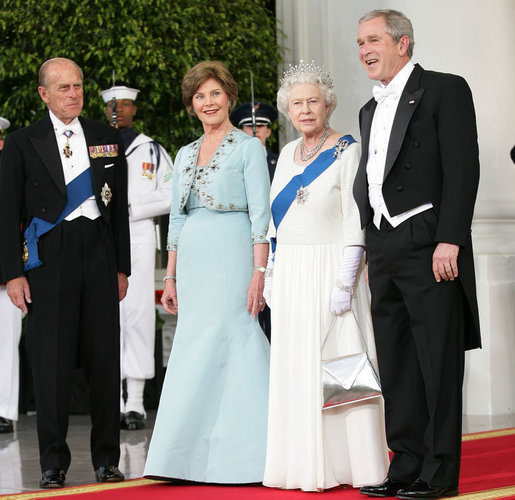
Notice how the tailcoat is still there? How it cuts back rather than slides down the same plane? Let’s look at Beast again, keeping this in mind:

Yup. That’s a tailcoat. In fact, look at those pants too. What do those look like?
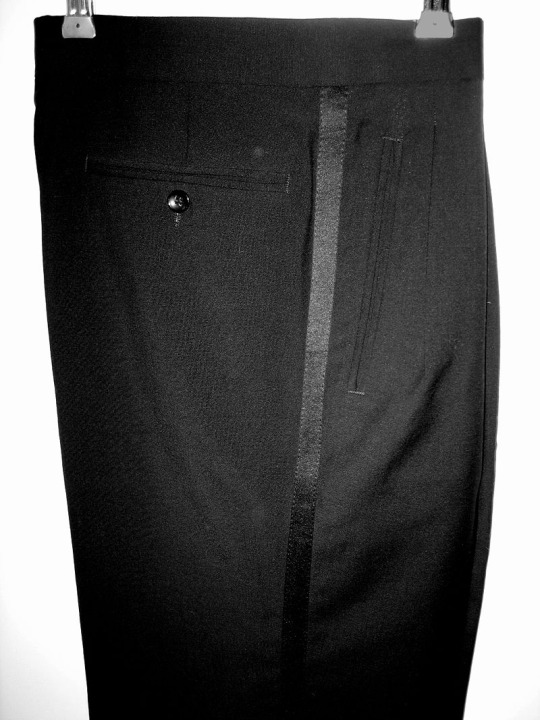
Oh, right, tuxedo pants with a side stripe. Which did not exist before The Great Male Renunciation.
But again you may be saying “You can’t base everything on evening dress! What about the others?! What about Lumiere and Cogsworth?!” Okay, let’s look at them. Human form, of course.

Firstly, I don’t exactly know what Lumiere is wearing there, why does he think an open vest (let’s not even try to call that a waistcoat) over shirtsleeves is going to fly at a royal party, but hey, let’s give him the benefit of the doubt of being an inanimate object for ten years, he’s still not totally up on sartorial codes.
So, his breeches and cuffs, those don’t look 19th OR 18th century. In fact, those breeches don’t look like breeches at all, they look like trunk hose, seen here on King James VI and I of Scotland and England (r. 1567/1603-1625) attributed to John de Critz circa 1605 (on display in the Museo del Prado in Madrid):

The cuffs also look 17th century as well, in fact if that’s supposed to be lace, it looks like the cuffs on van Dyck’s painting of Henri II of Lorraine painted 1634 (on display in the National Gallery of Art in Washington D.C):
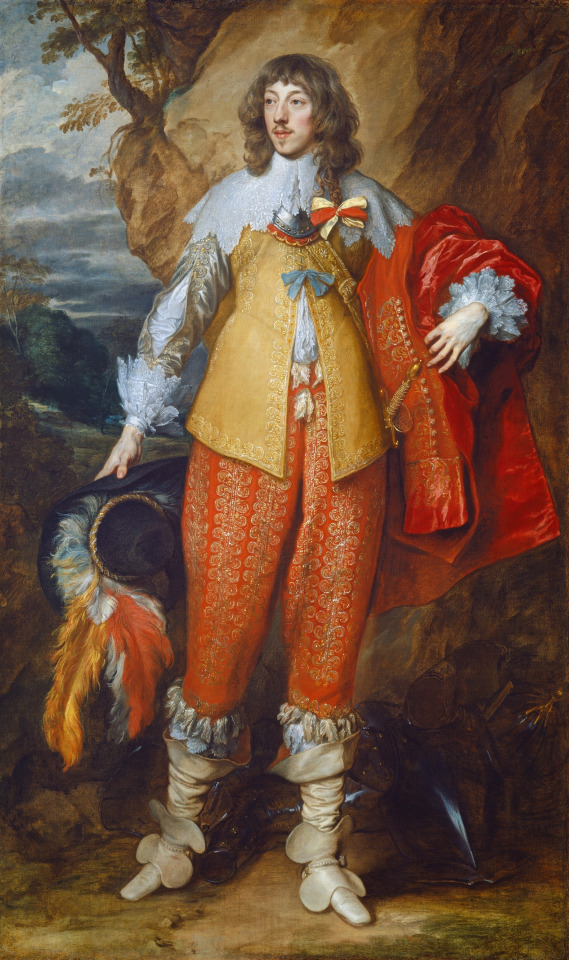
Why does Lumiere look so antique, even next to the theoretical timing of the 1760′s? Probably the same reason this member of staff at Buckingham Palace is dressed for the 1700′s (excepting the hat) while helping Kate Middleton with her wedding dress in 2011:
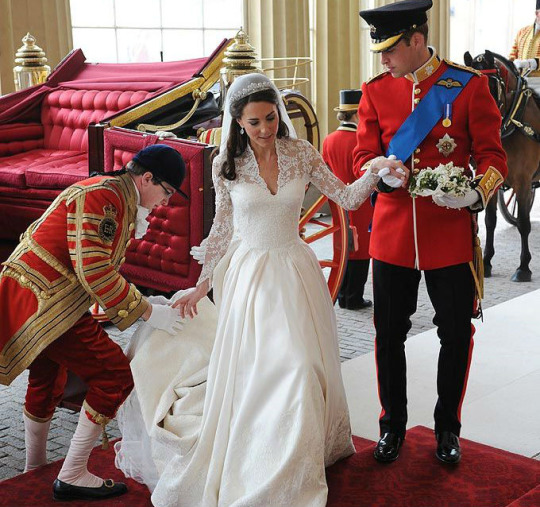
Servants of royal households (especially footmen) don’t exactly dress for the times, as it were. They get their livery and they wear it. You’ll see footmen dressed for the 1700′s as much as for the 1800′s nowadays, but in the 1800′s? Your footmen were livered for the previous century no doubt about it.
Cogsworth, as Head of the Household, has a bit more laxity about livery than Lumiere who is...never given a title. He’s just Lumiere. Cogsworth is Head of the Household, rather like a butler, Mrs. Potts is Housekeeper, and Lumiere is...well he’s Lumiere. For arguments sake let’s make him First Footman to be approaching equal status as the others and leave it at that.
Now you may be saying again, “But! Servants maybe aren’t great indicators, sure, but what about the town?! What about Gaston?!” Well, okay.

No one looks like a weird 19th century re-imagining of medieval eras like Gaston, I guess. Look at that tunic and hose. Looks more like Phillippe le Bon, Duke of Burgundy than a 1700′s man:

(Granted, Phillippe here is wearing poulaines, a popular long-toed shoe from the 15th c. rather than boots)
19th century re-imaginings of the medieval era were very common (looking at you, Viollet-le-Duc re-imagining what Notre Dame de Paris should have looked like). Dressing like it, maybe not. But nothing about Gaston says “1700′s” to me.

(Though, neither do these two kids with a turtle outside the bookshop during “Belle” so maybe this is a weird medieval town?)
Let’s take a look at when he’s dressed up to the nines for his “wedding” shall we? Just to keep it fair. Maybe he’s having an off day, sartorially during “Belle.”
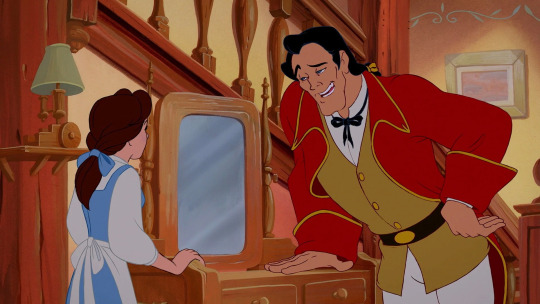
What’s that line in that wedding coat? It seems to move back into being tails like a tailcoat again. Let’s investigate further.

Yup. Sure looks like that diverts into being tails in this silhouette shot.
So Beast and Gaston are both dressed for the 19th century and Great Male Renunciation with those tailcoats, even if Gaston absolutely must keep to his color palette.
For the sake of covering all our bases, let’s talk about his gun for a second, too. Again, I am an art historian, not a military historian, so I’m not claiming to have full knowledge about all this, mind. But this gun looks like a blunderbuss to me.

Gaston’s gun

Ottoman Blunderbuss gun, Circa 1820 (private collection (Knohl Collection))
Notice the barrel shapes? You might even say Gaston’s is exaggerated for visual interest, but there was a very special gun auctioned off in 2016 by Woolley and Wallis, Auctioneers:

This is a “Fitzgerald patent flintlock signal trumpet, converted musket” that was “sold by appointment to Thomas Clio Rickman” by Willam Fitzgerald in the early 19th century and was patented in 1799.
Granted, this is not a common gun, it was patented, after all, but it does exist. And note the year of 1799, on the cusp of the 19th century, and certainly not the 1760′s.
Now you may be saying “But the Beast is a Prince! So it must be the 1700′s or the Revolution would have happened!”
The French Revolution of 1789 was a big deal, of course, and yes it did execute plenty “aristos.” Let’s not forget, however, that no one knew the Beast’s castle was there, so the Jacobins probably weren’t beating down the door of the castle anyway and planting liberty trees in the middle of Belle’s “poor provincial town” (unless that weird medieval kid was actually wearing a Phrygian Cap........)
But here’s something to keep in mind. Well, quite a few things.

When can a man have the title “Prince” in France? Well, the Ancien Regime, of course, and even further back than that. Let’s say Frankia as a starting point c.800 for clarity’s sake, all the way through 1792.
“Why not 1789? That’s the Revolution!” Well, it was the start of it, yes. And it was the storming of the Bastille. But the Revolution began with a period of a Constitutional Monarchy. It wasn’t officially a Republic until 1792, once Louis XVI’s head was in a wicker basket.
Moving on, you could be a Prince as well under Napoleon’s Empire, under the Restoration and the July Monarchy, and Napoleon III’s Second Empire. And even when those fell, people kept their titles. They weren’t getting murdered for them, after all.
Beast being a Prince does not necessitate him to have been alive before 1789. There’s a reason the 1800′s are called the Long Nineteenth Century, a lot of stuff happened really fast all the time. This list doesn’t even cover that time that the city of Paris became an anarchistic commune and so the National Guard was sent out to murder between 10,000 and 20,000 people for it.
All in all, “Beauty and the Beast” is styled to the 1800′s. It’s just obvious once you start looking at it and comparing it to the supposed time it’s equated to. Disney making it into the 1700′s in the live action remake is buying into incorrect readings of it, just like how they made the egg seller sing “That’s too expensive” during “Belle” when the original line is sung by this guy buying a jug.

37 notes
·
View notes